Caring for a Pig as a Pet: The Pot-bellied Pig and the Micro Pig
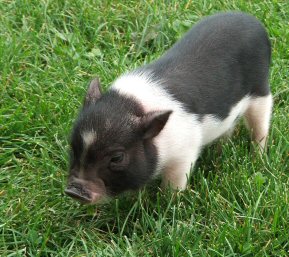 The Evolving Popularity of the Pig as a Pet The Evolving Popularity of the Pig as a Pet
Pigs are not only popular commodities in the form of pork products, but they are
bred to be pets as well. While the pot-bellied pig has been considered a pet for
some years, the micro pig which is bred to stay small, is emerging as a new kind
of miniature pet hog.
Introducing the Pot-bellied Pig or PBP
The pot-bellied pig (PBP) was a trendy choice for a pet in the 80s and at that
time, was available in black. Today, the pig can be adopted in colors such as
tan, gray, or white, or in a pinto (spotted) variation too. Male pigs are
classified as boars, females are defined as sows, and females who have not
produced a litter are referred to as gilts.
The pig originates from Vietnam and China and is crepuscular (active during
twilight) or nocturnal in nature. However, the pig can adapt to daytime hours if
acquired as a pet. While the animal's eyesight is not so good, the pig does
possess excellent senses of hearing and smell. The little heavyweight stands
around a foot to a foot and a half in height, and can get as big as 150 to 175
pounds. You can litter train or housetrain a pot-bellied pig and teach it
commands as well.
The PBP is different than a regular pig as it exhibits a longer snout, has
ears that are more upright, and possesses a straighter tail. A pet PBP does not
like to be hugged (he perceives a hug as a threat). So, youíll have to refrain
from hugging your pig as he doesnít view the action in the same way as a dog or
cat.
Training Your PBP: Let Him Know Youíre The Leader of the
Herd
That being said, you still need to make sure that your pig knows that youíre the
leader of the herd. That means practicing patience when teaching your pig to
obey as he may become pigheaded when he is being trained. As long as you stay
consistent in your teaching approach, your pig will grow up to be a well-behaved
pet.
Again, pigs can be trained to sit or stay and can be either housetrained or
litter trained. A PBP is a highly intelligent animal, so make sure that what you
teach him does not work against you. Pigs have been known to open cupboard doors
and get into other off-limit areas that are not secured.
Provide Your Pig with Enough Space Outdoors
If you do make the decision to adopt a pot-bellied pig as a pet, make sure you
have enough space outdoors to accommodate his needs for exercise as well as
rooting and foraging. Because a pot-bellied pig is considered to be a herd
animal, he fares well in a yard that gives him ample room to roam as well as to
dig and graze. If you live in a less roomy space, you can teach your pot-bellied
pig to walk beside you on a leash.
Bedding for Your Pig
Also, to make sure your pig is optimally content, provide him with a large dog
bed or several soft and comfortable blankets in which he can relax. Wood
shavings, or shredded flannel or cardboard can also be added to his bed.
Tick Prevention and Control
Always make sure that the place where your pig sleeps is clean and disinfected
to prevent the possibility of infection. Examine your PBP for ticks periodically
as they can also be a problem. While a pigís tough hide can be hard for a tick
to penetrate, the tiny bloodsucking bug can make its way into such areas as the
pigís neck, ears, or groin area. Ticks not only make the pig feel uncomfortable,
but they can spread Lyme disease and cause anemia.
Ticks with both soft and hard bodies are known to affect pigs and look like
small raisins when found on the animal. Use treatments or sprays that are
designed specifically for tick control.
Trimming Your Pigís Hooves
Have your PBPís hooves trimmed annually or every two years. If you exercise or
walk your pig regularly, his hooves wonít need to be shaved down as frequently.
Nutrition and Basic Care
Pigs will eat anything. So, keep your pig trim and healthy by feeding him plenty
in the way of veggies, fruits, and roughage. If your pig spends some time
indoors, you might opt to feed him a specially formulated pig chow recommended
by your vet. In addition, youíll need to vaccinate your pot-bellied friend and
have him wormed as well.
Toxic Plants to Pigs
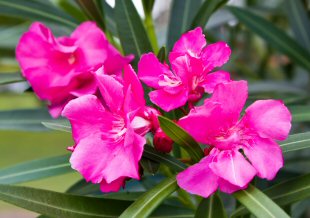 Because pigs naturally like to root for insects as well as eat plants, youíll
have to make sure that the plants inside and outside your home are not
poisonous. Some of the plants that can be fatal to pot-bellied pigs include
azaleas, mistletoe, or types of oleander. So, keep your pet away from these
plants. Because pigs naturally like to root for insects as well as eat plants, youíll
have to make sure that the plants inside and outside your home are not
poisonous. Some of the plants that can be fatal to pot-bellied pigs include
azaleas, mistletoe, or types of oleander. So, keep your pet away from these
plants.
Make Sure Chemicals or Medicines are Kept Out of Reach and Away from Your
Pet
Also, keep any products used for cleaning away from your pig, some of which can
harm the animalís digestive tract, tongue, mouth, or snout. Only give
medications that are recommended by your vet as human medicines can have adverse
or fatal side effects. For example, a mere 500 mg of acetaminophen can damage
the liver a small piglet.
Other Toxic Substances
Chocolate is also off-limits if you own a pig as the substance can result in
pancreatic difficulties. Other items or substances that are toxic or lethal to
pot-bellied pigs include the following:
-
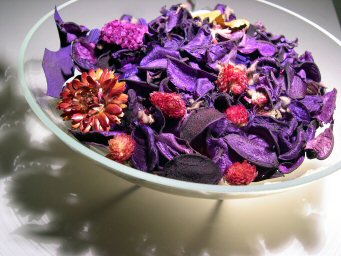 Mothballs Mothballs
- Pennies
- Dryer sheets
- Salt
- Potpourri
- Dishwasher detergents
- Playdough
- Batteries
- Coffee grounds
- Motor oil
- Antifreeze
- Windshield washer fluid
- Alcoholic beverages
- Cigarettes
Precautions to Take
Also, be careful about using herbicides, fertilizers, and insecticides in
your yard. Keep your pet away from any spot thatís sprayed until it is
completely dry. In addition, refrain from discarding spoiled food, old
prescriptions, over-the-counter medicines, or chemical products in the garbage.
Certain food molds can cause severe digestive problems too.
When is a PBP Considered Full-grown?
A pot-bellied pig is considered full-grown when it reaches three years old.
If you take good care of your pig, he should live from 12 to 15 years. The
gestation period for pigs is just under four months. Pigs, contrary to popular
belief, convey little, if any, odor.
The Evolution of the Mini Pig as a Pet
As mentioned, the micro or mini pig has emerged today as a new kind of pet
pig. While the regular-sized PBP was considered a miniature hog during the 80s
and 90s, miniature pigs today can weigh as little as 20 or 30 pounds.
Thatís quite a difference from regular pigs, which are raised for food, that
can get as big as 1,000 pounds. Needless to say, a large 500 or 600 pound hog is
just too damaging to oneís furniture if itís taken in as a pet. Not to mention
quite weighty if it sits on your lap, (it would most likely cause damage to your
body if a full-grown pig jumped into your lap).
Over the past two decades then, a smaller pig has evolved by selective
cross-breeding and breeding practices. At first, pigs were bred smaller for the
purposes of scientific research. However, breeders found that by breeding more
diminutive pigs, they could be adopted as pets as well.
Examples of Miniature Pig Breeds
Miniature breeds that are now featured as popular pigs for pets include the
following:
Miniature Potbellied Pigs (PBPs). The miniature PBPs are well-liked as they
are docile in nature and intelligent. Averaging around 18 inches in height, they
generally weigh no more than 100 pounds.
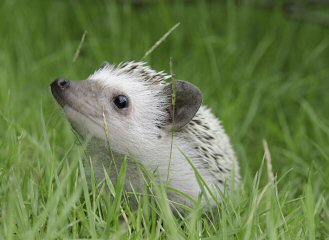 The Guinea Hog (also referred to as the African Pygmy). This miniature pig
weighs, on average, around 30 pounds and generally stands between a foot and a
foot and a half at the shoulder. Unlike PBPs, guinea hogs have straight rather
than swayed backs. The little pigs make ideal pets as they are quite
affectionate. The Guinea Hog (also referred to as the African Pygmy). This miniature pig
weighs, on average, around 30 pounds and generally stands between a foot and a
foot and a half at the shoulder. Unlike PBPs, guinea hogs have straight rather
than swayed backs. The little pigs make ideal pets as they are quite
affectionate.
The Painted Miniataure Pig (Juliani). This miniature breed stands around 14
inches high and can weigh between 20 and 60 pounds. Gentle in nature, the pigs
also love to play. A painted miniature has a longer snout and legs than a
miniature PBP.
The Mexican Hairless Pig or Yucatan. Yucatans are bred in small and larger
sizes. Smaller pigs weigh between 60 and 100 pounds, while the larger pigs can
weigh as much as 200 pounds. The pigs usually stand between 18Ē and 24Ē at the
shoulder.
The Ossabaw Island Pig. Weighing between 30 and 90 pounds, these pigs stand
around a foot and a half in height. The highly intelligent Ossabaw is a
preferred pet as it bonds well with its human companions and can be easily
trained. Whatís more, the healthy and hardy little pig can live two decades or
more.
The classifications listed below further define the differences between the
smaller pig varieties.
- Miniature PBPs weigh up to 100 pounds and grow to a height of around 18
inches.
- Micro Pigs stand, on average, about 14Ē at the shoulder. They weigh less
than mini PBPs and exhibit a straight back, longer legs, and smaller stomach.
- Mini Micro Pigs grow to an average height of about a foot. They look like a
micro pig except that they're smaller in size.
- Mini Juliana Pigs stand around 12 to 14 inches, on average. The spotted
pigs, also referred to as painted pigs, have the distinction of being the
smallest of the mini pig breeds.
Nutrition for the Mini Pig
Pig Chow for Mini PBPs
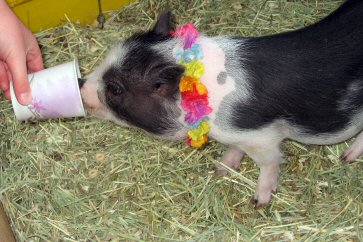 As overfeeding can be a problem when caring for miniature breeds, itís
important to learn the proper foods to give your pig as well as the foods to
avoid. A number of companies manufacture pig chow for mini PBPs. Organic chows
are produced that supply the protein a pig requires that he canít get on their
own. No fillers, such as corn or soy, are added in the mix. As overfeeding can be a problem when caring for miniature breeds, itís
important to learn the proper foods to give your pig as well as the foods to
avoid. A number of companies manufacture pig chow for mini PBPs. Organic chows
are produced that supply the protein a pig requires that he canít get on their
own. No fillers, such as corn or soy, are added in the mix.
Mini PBPs that eat chow need the food as they donít have easy access to the
worms, bugs, soil, and vegetation that they do in the wild. Pigs should be fed
at the same times, twice a day. The chow should contain about 12% protein.
What You Shouldnít Feed Your Mini Pig
Never feed your mini pig cat food or dog food as the protein levels in both
kinds of meals are too high for a pig. If your pig grazes a good deal, then you
can reduce the amount of food given at feeding time. Also, never give your mini
pig such foods as onions, meal scraps, junk food, corn, potatoes, or tomatoes.
Recommended Vegetables and Treats
Instead, feed your pig darker hued vegetables. Include such foods and treats
as carrots, green peas, peppers, and leafy greens. Mini pigs also like popcorn
and shredded wheat. Supply your mini pig with fresh, clean water every day.
Watch the Following Video
Mini pigs are featured on the following video:
Pets
Top Lists:
18 Richest Animals in the World
15 Exotic Pets You Could Own Today
Top 20 Common Substances That Are Toxic to Cats and Dogs
Informational:
Animal Actors: Pets in the Film, TV, and Print Industry
Caring for a Yorkshire Terrier: Facts You Should Know
Caring for a Pig as a Pet: The Pot-bellied Pig and the Micro Pig
Difference Between a Cat Person And a Dog Person
Should You Microchip your Cat or Dog?
How to Raise and Care for Pygmy Goats
Caring for Unique Pets: The Leopard Gecko
Use Food-Grade Diatomaceous Earth to Kill Fleas Naturally
Dogs:
Top Lists:
Top 15 Dog Breeds For Home Protection
15 Fascinating Facts About The Mastiff
Informational:
How To Teach Your Dog to Hunt for Truffles
Caring for an English Bulldog: Tips and Basic Info
Cranial Cruciate Ligament (CCL) Tears in Dogs: Treating the Injury
How To Keep Your Dog free of Heartworm Disease
Dog With Separation Anxiety?
Cats:
Top Lists:
Top 6 Qualities in an Awesome Cat
Informational:
How to Control Fighting Felines
How to Get Your Cat to Exercise
Fish:
Fish 101 for the Hobbyist: The Fishís Body and Senses
Buying a Saltwater Aquarium: What You Need to Know
Graduating to a Saltwater Tank
|